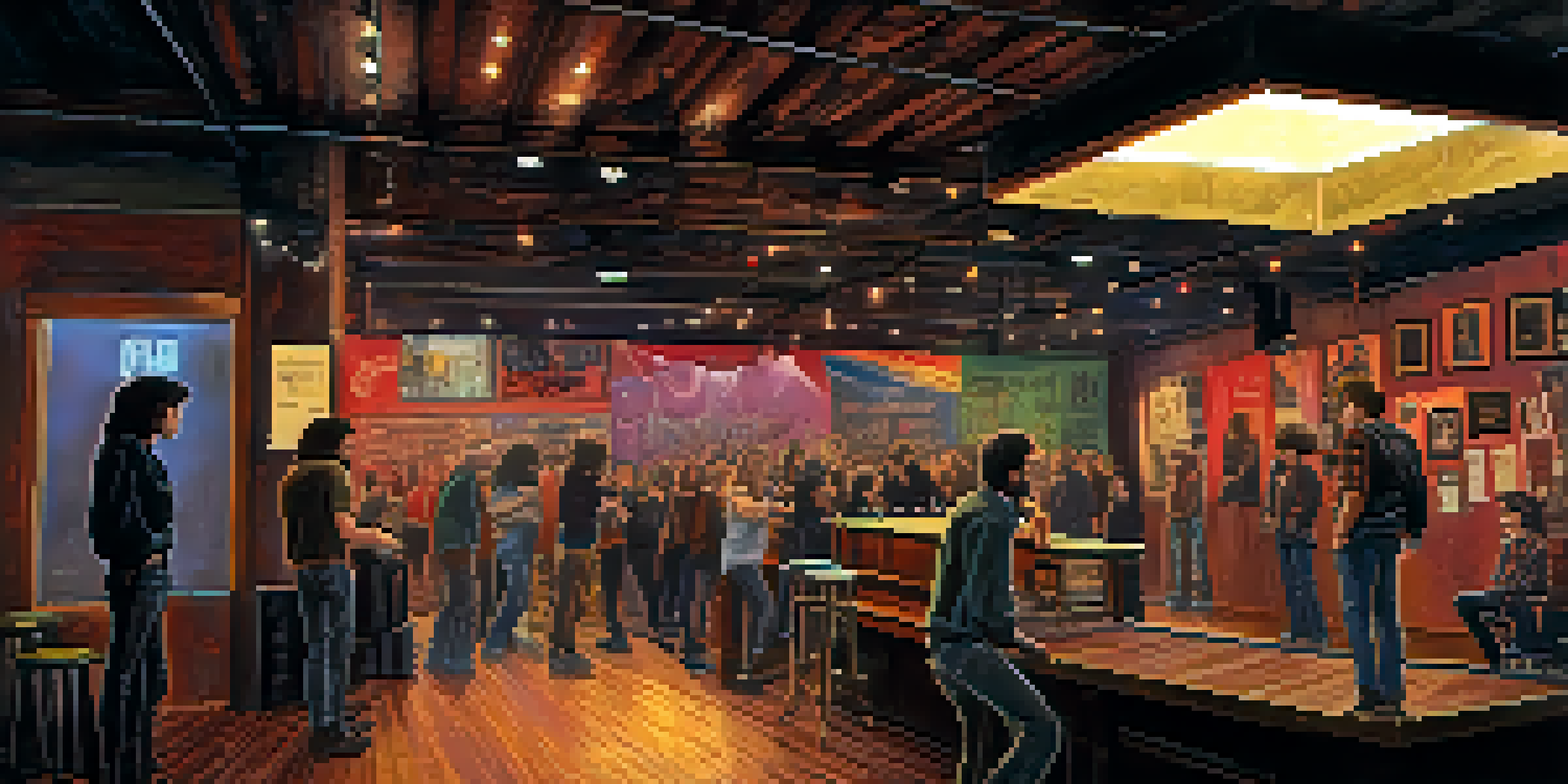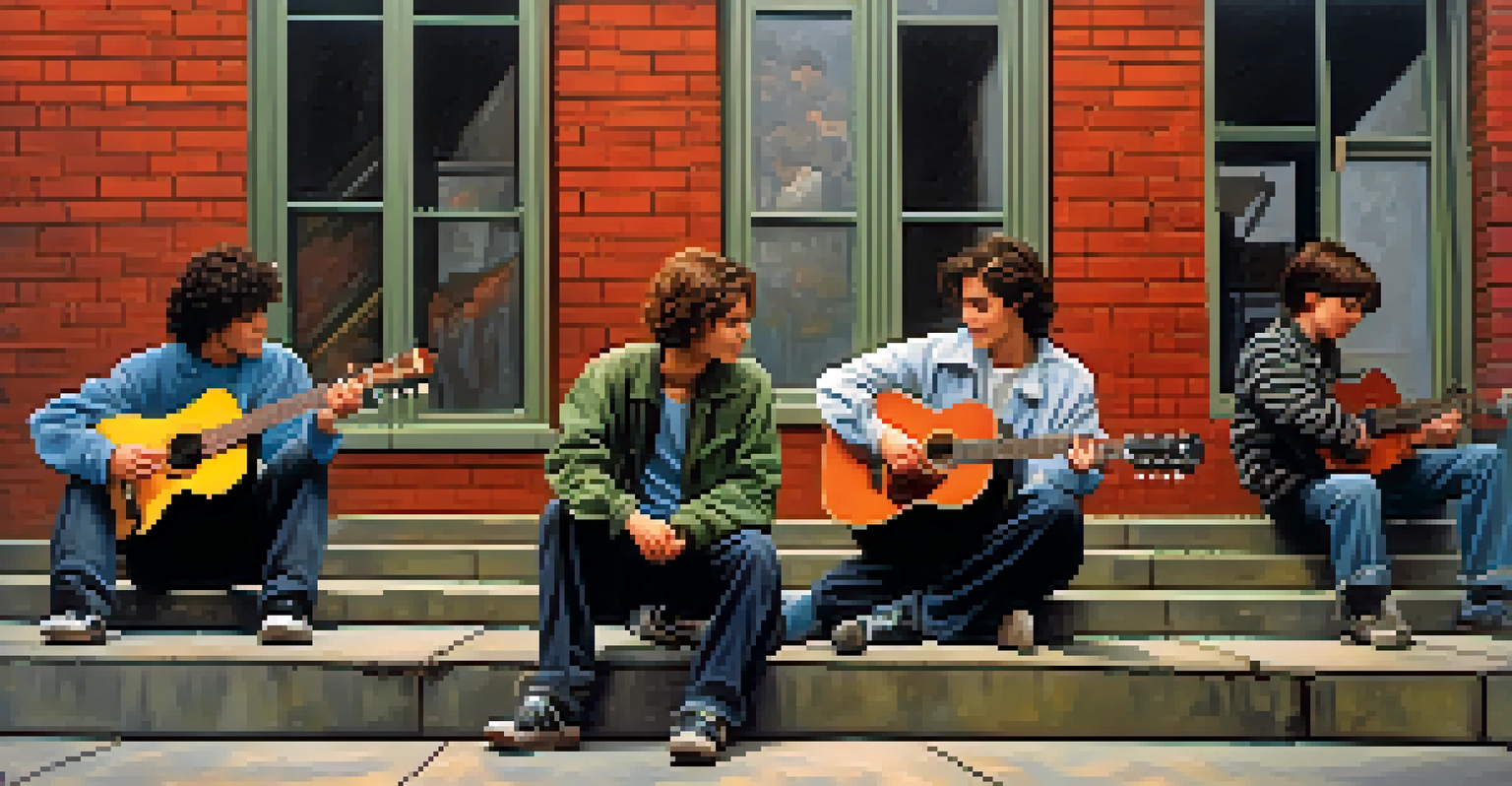Nirvana's Rise: How Seattle Became the Heart of Grunge Music

The Birth of Grunge: Seattle's Unique Music Scene
In the late 1980s, Seattle was an underground hub for musicians looking to break away from mainstream sounds. The city's rainy weather and countercultural vibe fostered a sense of authenticity, attracting artists who wanted to express raw emotions. Venues like The Crocodile and Central Tavern became breeding grounds for new sounds, paving the way for what would soon be known as grunge.
Grunge is a reaction to the commercialism of the 1980s. It’s about being real and raw, not glossy and perfect.
Local bands like Soundgarden and Mudhoney were instrumental in creating a gritty sound that combined punk rock's aggression with heavy metal's weight. These bands not only set the stage but also inspired a younger generation of artists, including Nirvana. By blending diverse influences, these musicians captured the angst of a disenchanted youth, leading to a seismic shift in the music landscape.
As the scene continued to grow, it became a close-knit community where collaboration was key. Musicians often supported one another, leading to cross-pollination of styles and ideas. This sense of camaraderie helped solidify Seattle as the epicenter of the grunge movement.
Nirvana's Formation: The Catalyst for Change
Nirvana formed in 1987, with Kurt Cobain and Krist Novoselic at the helm, setting the stage for a new era in rock music. Their sound was distinct, characterized by catchy melodies layered over gritty guitar riffs, which both challenged and captivated listeners. The band's ethos resonated with the feelings of alienation and disillusionment prevalent among youth at the time.

The 1991 release of their breakthrough album, 'Nevermind,' catapulted them into the national spotlight. The single 'Smells Like Teen Spirit' became an anthem for a generation, encapsulating the essence of grunge. This sudden popularity brought attention not only to Nirvana but also to the entire Seattle music scene, leading to a surge of interest in other local bands.
Grunge's Roots in Seattle's Scene
Seattle's underground music scene in the late 1980s fostered the raw, authentic sounds that defined grunge.
Nirvana's success was not just a fluke; it was a culmination of years of hard work and grassroots promotion. They played gigs in small venues and connected with fans on a personal level, establishing a devoted following that would only grow as their music reached a wider audience.
The Role of Sub Pop: Seattle’s Music Label Phenomenon
Sub Pop Records, founded in 1986, played a crucial role in shaping the grunge movement and promoting Seattle bands. With a focus on emerging artists, the label helped bring Nirvana and other local bands to a national audience. Their innovative marketing strategies, including the now-iconic 'Seattle Sound' branding, captured the essence of the city’s music scene.
Nirvana is a band that has been an inspiration to other artists, and we were part of that grunge scene that truly represented the voice of our generation.
The label's early investments in bands like Soundgarden and Mudhoney laid the groundwork for Nirvana's success. Sub Pop was not just a record label; it became a cultural institution that represented the raw energy of the Seattle music scene. They helped create a sense of identity around grunge, elevating it from an underground movement to a global phenomenon.
As Nirvana’s fame grew, Sub Pop continued to support new talent, ensuring that the spirit of grunge lived on. By nurturing a diverse range of artists, they kept the Seattle music scene vibrant and relevant, solidifying the city's reputation as the heart of grunge.
The Impact of MTV: Grunge Goes Mainstream
The early 1990s marked a turning point for grunge as MTV began to embrace the genre, showcasing bands like Nirvana on a national platform. The network's '120 Minutes' and 'Headbangers Ball' introduced millions to the raw sounds of Seattle, changing the way music was consumed. Nirvana's music videos, particularly for 'Smells Like Teen Spirit,' became cultural touchstones that defined an era.
MTV's support helped propel grunge into the mainstream, allowing Nirvana and other Seattle bands to reach audiences far beyond their hometown. This exposure brought significant attention to the genre, influencing a wave of artists who sought to replicate that grunge aesthetic. However, it also posed challenges, as some bands struggled to maintain their authenticity amid commercial pressures.
Nirvana's Impact on Mainstream Music
Nirvana's breakthrough in the early 1990s propelled grunge into the mainstream, influencing a generation of artists.
While the mainstream success was exhilarating, it also sparked debates about the commercialization of grunge. Many artists worried that the essence of their music was being diluted in pursuit of profit. Despite these concerns, Nirvana remained committed to their roots, using their platform to address social issues and speak out against the very commercialization that sought to define them.
The Legacy of Kurt Cobain: A Lasting Influence
Kurt Cobain's tragic death in 1994 marked a pivotal moment for both Nirvana and the grunge movement. While it signaled the end of an era, it also solidified Cobain's legacy as a voice for a generation. His struggles with fame, mental health, and substance abuse resonated deeply with fans, making him an enduring symbol of the complexities of rock stardom.
Cobain's impact extended beyond music; he became a cultural icon whose influence can still be felt today. His authenticity and vulnerability inspired countless musicians and artists to embrace their true selves, fostering a new wave of creativity. The raw emotion in Nirvana's music encouraged others to explore themes of pain, love, and identity in a way that felt accessible and relatable.
Even years after his passing, Cobain's influence can be seen in contemporary music, shaping genres from alternative rock to pop. His legacy is a testament to the power of music as a means of expression, reminding us that the feelings of isolation and angst he articulated are still relevant today.
Grunge’s Evolution: From Seattle to the World
As grunge gained popularity, its influence began to spread beyond Seattle, inspiring bands across the globe. The genre's signature sound—characterized by heavy guitar riffs, introspective lyrics, and a DIY ethos—became a blueprint for new artists emerging in the '90s and early 2000s. Bands like Alice in Chains and Pearl Jam followed in Nirvana's footsteps, further solidifying Seattle's place in music history.
However, the commercialization of grunge led to a dilution of its original message, sparking a backlash from purists. Many traditionalists felt that the mainstream's embrace of grunge had stripped away its authenticity, leading to a wave of criticism directed at bands perceived as 'selling out.' Despite this, the genre continued to evolve, blending with other styles and inspiring new movements.
Grunge's Lasting Cultural Influence
The spirit of grunge continues to resonate in Seattle's culture and music, inspiring new generations of artists.
Today, grunge's legacy can be seen in various music styles, from emo to indie rock. The influence of Seattle's grunge scene has permeated popular culture, reminding us that music is a powerful vehicle for change and expression.
The Enduring Spirit of Seattle and Grunge Culture
Even as music trends have changed, the spirit of grunge remains deeply embedded in Seattle's culture. The city continues to celebrate its musical heritage through festivals, museums, and local venues that honor the legacy of grunge artists. Events like the Seattle International Film Festival and the Bumbershoot Music Festival showcase local talent while paying homage to the city's rich musical history.
Moreover, Seattle's music scene has evolved, giving rise to a new generation of artists who draw inspiration from grunge's rawness while infusing their own unique styles. This blend of old and new helps keep the grunge ethos alive, ensuring that its influence endures in contemporary music.

The story of grunge is not just about the music; it's about the community, the struggles, and the spirit of rebellion that defined a generation. As long as there are musicians willing to channel their emotions into their art, the heart of grunge will continue to beat in Seattle and beyond.